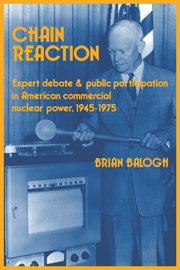 Chain Reaction
Chain Reaction Book contents
- Frontmatter
- Contents
- Acknowledgments
- List of abbreviations
- 1 From fission to fusion: professionalization and politics in twentieth-century America
- 2 The promise of the proministrative state: nuclear experts and national politics, 1945–1947
- 3 Forging an iron triangle: the politics of verisimilitude
- 4 Triangulating demand: the Atomic Energy Commission's first decade of commercialization
- 5 The centrifugal push of expertise: reactor safety, 1947–1960
- 6 The magnetic pull of professional disciplines, issue networks, and local government
- 7 Nuclear experts on top, not on tap: mainstreaming expertise, 1957–1970
- 8 Nuclear experts everywhere: the challenge to nuclear power, 1960–1975
- 9 Conclusion: harnessing political chain reactions
- Index
5 - The centrifugal push of expertise: reactor safety, 1947–1960
Published online by Cambridge University Press: 07 May 2010
- Frontmatter
- Contents
- Acknowledgments
- List of abbreviations
- 1 From fission to fusion: professionalization and politics in twentieth-century America
- 2 The promise of the proministrative state: nuclear experts and national politics, 1945–1947
- 3 Forging an iron triangle: the politics of verisimilitude
- 4 Triangulating demand: the Atomic Energy Commission's first decade of commercialization
- 5 The centrifugal push of expertise: reactor safety, 1947–1960
- 6 The magnetic pull of professional disciplines, issue networks, and local government
- 7 Nuclear experts on top, not on tap: mainstreaming expertise, 1957–1970
- 8 Nuclear experts everywhere: the challenge to nuclear power, 1960–1975
- 9 Conclusion: harnessing political chain reactions
- Index
Summary
Just as the most basic political relationships between agency, Congress, and interest groups had to be constructed after the AEC's inception, health and safety regulation – usually sharply demarcated from development – was also constructed within the AEC. Contemporaries were quick to point out the unusual nature of this arrangement. But few challenged self-regulation in the early years. National security is the factor most commonly cited. One need look no farther than today's Department of Energy and the degree to which it continues to regulate its own weapons production plants to recognize how influential national security can be in distorting traditional patterns of oversight and review. Expertise and the way it was organized, however, were also central to the political evolution of safety review as it related to the development of commercial nuclear power.
Because nuclear power was not far removed from the laboratory, only a handful of experts understood the complexities of nuclear power: those who designed reactors were also the leading authorities on their safety. The AEC's initial approach to safety was modeled on the Manhattan Project's techniques. There, reactor designers were nothing less than jacks of all trades. As Enrico Fermi's assistant noted, Fermi “eagerly participated in constructing the ‘piles,’ in making measurements, in repairing instruments, etc.” Fermi was also in charge of safety. He was prophetic about the nature of reactor problems. After a lengthy brainstorming session with his assistants and Du Pont one day, Fermi was asked which of the many problems discussed might prove most troublesome.
- Type
- Chapter
- Information
- Chain ReactionExpert Debate and Public Participation in American Commercial Nuclear Power 1945–1975, pp. 120 - 148Publisher: Cambridge University PressPrint publication year: 1991


